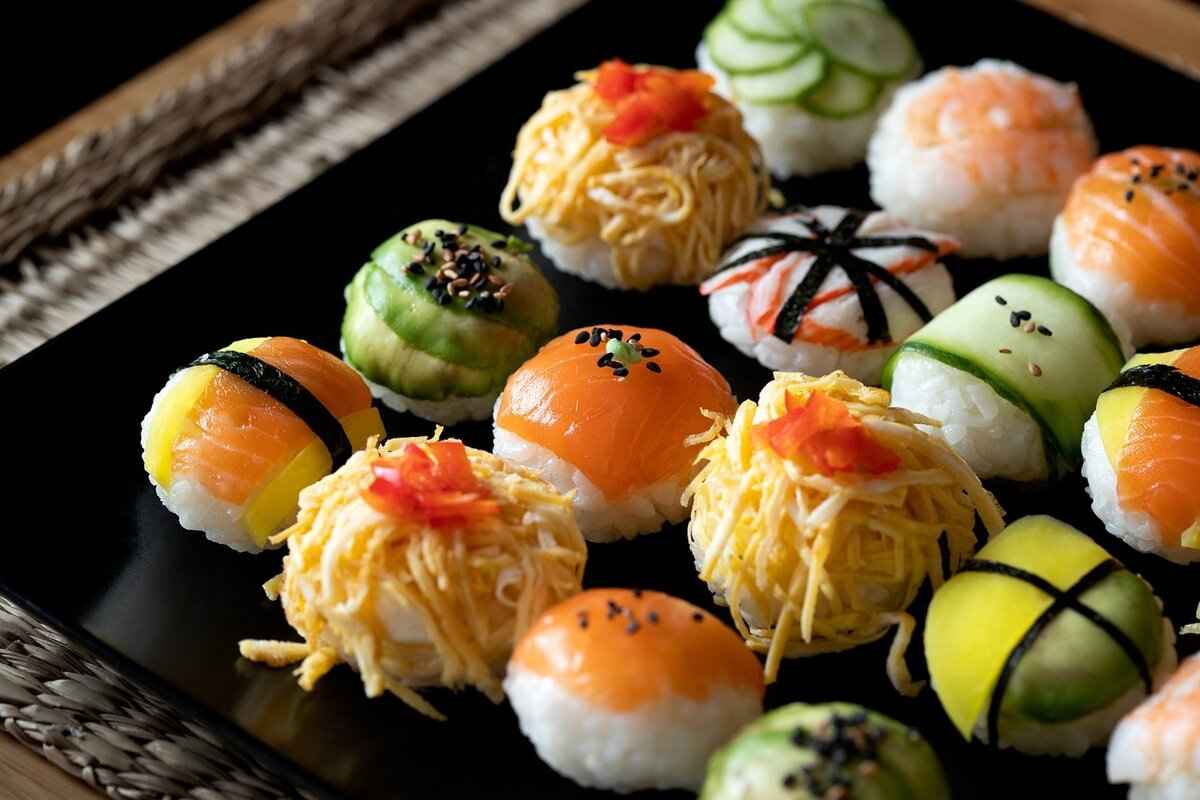This article delves into the integral role of food in traditional Japanese and Korean weddings, highlighting the cultural significance, unique dishes, and the rituals surrounding these culinary traditions. Food is not merely a means of sustenance; it serves as a vital component in celebrating love and unity, reflecting the couple’s hopes and dreams.
In Japanese weddings, food symbolizes prosperity and happiness. The culinary offerings often feature seasonal ingredients that resonate with the couple’s desires for a fruitful life together. This thoughtful selection enhances the overall celebratory atmosphere, making the dining experience as memorable as the vows exchanged.
Japanese wedding cuisine is renowned for its elegance and artistry. One of the most celebrated dishes is Kaiseki, a multi-course meal that embodies seasonal flavors and meticulous presentation. Each dish is designed to reflect the couple’s hopes for a harmonious future, making Kaiseki a centerpiece of the wedding feast.
The preparation of Kaiseki involves a careful selection of ingredients and intricate cooking methods. Each dish carries a specific meaning, such as longevity or wealth. The meticulous attention to detail ensures that every plate served is not only a treat for the palate but also a symbol of good fortune.
Common ingredients in Kaiseki include fresh seafood, seasonal vegetables, and rice. Each component is chosen for its symbolic significance; for instance, shrimp represents longevity, while lotus root signifies clarity in the couple’s future. This thoughtful curation of ingredients enhances the meal’s overall meaning.
The presentation of Kaiseki is an art form, with dishes arranged to reflect nature and the seasons. This visual appeal not only complements the flavors but also enhances the overall dining experience, creating a feast for both the eyes and the palate.
Besides Kaiseki, other traditional foods such as Sushi and Sake are frequently served. Each of these dishes carries its own symbolism, contributing to the festive atmosphere of the wedding celebration and reinforcing the cultural heritage.
In Korean weddings, food plays a crucial role, symbolizing abundance and fertility. Specific dishes are prepared to honor ancestors and bless the newlyweds, reinforcing family ties and cultural heritage. This emphasis on food reflects the deep-rooted traditions that are integral to Korean society.
Korean weddings typically feature dishes like Banchan, a variety of side dishes, and Galbijjim, braised short ribs. These dishes are carefully chosen for their symbolic meanings and their contributions to a bountiful life together.
Banchan, served in small portions, represents the couple’s gratitude to their guests and families. This assortment showcases a variety of flavors and textures, reflecting the richness of Korean cuisine and culture, and enhances the communal spirit of the celebration.
Galbijjim is often served as a symbol of wealth and prosperity. Its rich flavors represent the couple’s wishes for a fulfilling and abundant life together, making it a favorite at wedding feasts and an essential part of the celebratory menu.
Both Japanese and Korean wedding rituals incorporate food to honor tradition. Specific ceremonies involve the sharing and consumption of symbolic dishes, reinforcing the cultural significance of food in marital unions and creating lasting memories for the couple and their guests.
While both cultures emphasize the importance of food in weddings, their practices differ in dish selection and preparation methods. These differences reflect unique historical influences and culinary traditions, enriching each celebration and showcasing the diversity of Asian wedding customs.

What Role Does Food Play in Japanese Weddings?
Food in Japanese weddings is not merely a meal; it is a symbolic representation of the couple’s hopes and dreams for their future together. The culinary offerings during these ceremonies are carefully curated to reflect prosperity, happiness, and the couple’s aspirations for a fruitful life. This deep-rooted tradition enhances the celebratory atmosphere of the event, making it a memorable occasion for all attendees.
During a Japanese wedding, the food served is often a reflection of the seasonal ingredients available at the time, showcasing the beauty of nature and the couple’s connection to their surroundings. This attention to detail not only emphasizes the couple’s wishes for a harmonious life but also highlights the importance of seasonality in Japanese cuisine.
One of the most significant aspects of food in Japanese weddings is the concept of omotenashi, which translates to the spirit of selfless hospitality. This philosophy dictates that the hosts provide a dining experience that goes beyond mere sustenance, aiming to create a warm and welcoming environment for guests. The food served is thus an expression of gratitude and respect towards family and friends, enhancing the communal feeling of the celebration.
- Seasonal Ingredients: The use of seasonal ingredients in wedding cuisine symbolizes the couple’s desire for a life that is in harmony with nature.
- Symbolic Dishes: Each dish carries its own significance, such as shrimp for longevity and lotus root for clarity, reinforcing the couple’s hopes for their future.
- Elegant Presentation: The artful arrangement of dishes not only pleases the eye but also reflects the couple’s appreciation for beauty and craftsmanship.
The centerpiece of Japanese wedding cuisine is often the Kaiseki meal, a multi-course dining experience that showcases a variety of flavors and textures. Each course is meticulously prepared, with attention given to the visual presentation, making it a feast for both the eyes and the palate. The careful selection of ingredients and the intricate cooking methods used in Kaiseki signify the couple’s commitment to a harmonious and fulfilling life together.
In addition to Kaiseki, traditional foods such as Sushi and Sake are also commonly served. Sushi, with its vibrant colors and fresh ingredients, symbolizes the couple’s desire for a rich and varied life, while Sake, a traditional rice wine, is often used in ceremonial toasts, signifying unity and the sharing of joy.
Overall, food plays an integral role in Japanese weddings, serving as a bridge between tradition and modernity. It reflects not only the couple’s personal tastes but also their cultural heritage, making each wedding unique and meaningful. The thoughtful incorporation of food into the celebration enhances the overall experience, leaving lasting memories for both the couple and their guests.

What Are the Signature Dishes of Japanese Wedding Cuisine?
Japanese wedding cuisine is a splendid reflection of the country’s rich cultural heritage and culinary artistry. The food served at these celebrations is not merely a meal; it embodies the couple’s hopes and dreams for their future together. The elegance of Japanese wedding cuisine is demonstrated through its signature dishes, which are crafted with care and intention.
One of the most prominent dishes in Japanese wedding cuisine is Kaiseki. This multi-course meal is designed to showcase seasonal ingredients and meticulous presentation. Each dish within a Kaiseki meal is carefully curated to symbolize various aspects of life, such as harmony, prosperity, and longevity. The use of fresh, high-quality ingredients not only enhances the flavors but also reflects the couple’s wishes for a fruitful and fulfilling life together.
Another signature dish often featured during weddings is Sushi. This beloved Japanese dish comes in various forms, including nigiri, maki, and sashimi. Sushi is not only delicious but also symbolizes the couple’s unity, as the act of sharing sushi represents their commitment to one another. The vibrant colors and artistic presentation of sushi make it a visually appealing addition to any wedding feast.
Sake, Japan’s traditional rice wine, is also a staple at weddings. It is often served during the san-san-kudo ceremony, where the couple takes three sips from three different cups, symbolizing their union and the joining of their families. This ritual highlights the significance of Sake in Japanese culture, as it is believed to bring good fortune and blessings to the newlyweds.
The preparation of Kaiseki is an intricate process that involves selecting seasonal ingredients that not only taste exquisite but also carry symbolic meanings. For instance, shrimp is often included to represent longevity, while lotus root signifies clarity in the couple’s future. The chef’s skill in balancing flavors and textures, along with the artistic presentation, transforms each course into a work of art.
In Japanese culture, the presentation of food is as important as the taste. Kaiseki dishes are arranged to reflect the beauty of nature, often incorporating elements such as leaves, flowers, and stones to create a harmonious visual experience. This attention to detail not only enhances the dining experience but also conveys the couple’s appreciation for the beauty of life and nature.
Beyond Kaiseki, other traditional foods such as Tempura and Chawanmushi are often served. Tempura, which consists of lightly battered and fried vegetables and seafood, symbolizes the couple’s desire for a bountiful life. Chawanmushi, a savory egg custard, represents the nurturing aspect of marriage. Each dish is selected with care, ensuring that it contributes to the overall theme of celebration and joy.
The signature dishes of Japanese wedding cuisine are steeped in cultural significance. They not only reflect the couple’s aspirations but also serve to honor their families and traditions. Each ingredient and preparation method tells a story, creating a rich tapestry of flavors and meanings that enhance the wedding celebration.
In summary, Japanese wedding cuisine is a beautiful blend of tradition, symbolism, and artistry. The signature dishes, including Kaiseki, Sushi, and Sake, play a vital role in conveying the couple’s hopes for their future together. Through careful preparation and stunning presentation, these dishes elevate the wedding experience, making it a memorable celebration for all involved.
Kaiseki,
Kaiseki is a traditional multi-course Japanese dining experience that embodies the philosophy of seasonal ingredients and meticulous presentation. Originating from the Japanese tea ceremony, Kaiseki has evolved into a sophisticated culinary art form that plays a significant role in various formal occasions, particularly weddings. This article delves into the intricacies of Kaiseki, exploring its preparation, ingredients, and cultural significance.
Kaiseki is not just a meal; it is a culinary journey that reflects the couple’s wishes for a prosperous and harmonious future. Each dish is carefully curated to symbolize various aspects of life, such as longevity, happiness, and wealth. In the context of weddings, Kaiseki serves as a centerpiece that enhances the celebratory atmosphere, allowing guests to partake in the couple’s hopes and dreams.
The preparation of Kaiseki involves a meticulous process that emphasizes the use of fresh, seasonal ingredients. Chefs often engage in a careful selection process, ensuring that each dish not only tastes exquisite but also carries a specific meaning. For instance, ingredients like shrimp are chosen for their symbolism of longevity, while lotus root represents clarity in the couple’s future.
- Sashimi: Fresh raw fish served with soy sauce, highlighting the purity of ingredients.
- Chawanmushi: A savory egg custard that represents harmony.
- Tempura: Lightly battered and fried vegetables or seafood, emphasizing seasonal flavors.
- Grilled Fish: Often served whole, symbolizing completeness and prosperity.
The presentation of Kaiseki is an art form that aims to reflect nature and the seasons. Each dish is arranged thoughtfully, often using beautiful ceramics and seasonal garnishes. This visual appeal not only enhances the dining experience but also creates a connection to the natural world, making each meal a feast for the eyes as well as the palate.
Common ingredients in Kaiseki include:
- Fresh Seafood: Symbolizing abundance and prosperity.
- Seasonal Vegetables: Representing the changing seasons and the couple’s adaptability.
- Rice: A staple in Japanese cuisine, symbolizing sustenance and life.
In Japanese weddings, Kaiseki is often served during the reception as a way to honor guests and celebrate the union of the couple. The meal is typically accompanied by Sake, which enhances the flavors and adds to the festive atmosphere. The sharing of Kaiseki dishes among family and friends reinforces bonds and highlights the importance of community in Japanese culture.
While Kaiseki is unique in its presentation and philosophy, other wedding cuisines, such as Italian or Mexican wedding feasts, also emphasize the importance of food in celebrating unions. However, Kaiseki stands out due to its deep-rooted cultural significance and the focus on seasonal ingredients, making it a truly special experience.
In summary, Kaiseki is more than just a meal; it is a celebration of life, love, and the changing seasons, making it an integral part of Japanese wedding traditions.
a multi-course meal that showcases seasonal flavors and meticulous presentation, embodying the couple’s hopes for a harmonious future.
Food plays a central role in traditional weddings, particularly in cultures like Japan and Korea. The culinary traditions not only reflect the couple’s hopes for their future but also serve as a way to honor family and ancestors. This article delves into the significance of food in these weddings, focusing on the multi-course meal known as Kaiseki in Japan and various dishes in Korea.
Kaiseki is a traditional Japanese multi-course meal that is meticulously prepared to showcase seasonal ingredients. It embodies the couple’s aspirations for a harmonious future. The elegance of Kaiseki lies not only in its flavors but also in its presentation, which reflects the beauty of nature and the changing seasons.
The preparation of Kaiseki involves a careful selection of ingredients, each chosen for its symbolic meaning. For instance, dishes may include shrimp, representing longevity, and lotus root, symbolizing clarity in the couple’s future. The intricate cooking methods ensure that each course is a work of art.
- Fresh Seafood: Often signifies purity and freshness.
- Seasonal Vegetables: Reflect the time of year and the couple’s connection to nature.
- Rice: A staple that symbolizes prosperity and sustenance.
The presentation of Kaiseki is an art form, with each dish arranged to create a visual narrative. This enhances the dining experience, making it not just a meal but a celebration of life and nature.
In addition to Kaiseki, traditional Japanese weddings often feature Sushi and Sake. Each of these dishes carries its own symbolism, contributing to the overall festive atmosphere.
In Korean weddings, food symbolizes abundance and fertility. Specific dishes are prepared to honor ancestors and bless the newlyweds, reinforcing family ties and cultural heritage.
Korean weddings typically feature dishes like Banchan, a variety of side dishes, and Galbijjim, braised short ribs. Each dish is chosen for its symbolic meaning, contributing to a bountiful life together.
Banchan, served in small portions, showcases a variety of flavors and textures, representing the couple’s gratitude to their guests. This assortment reflects the richness of Korean cuisine and culture.
Galbijjim, with its rich flavors, symbolizes wealth and prosperity. It is a favorite at wedding feasts, representing the couple’s wishes for a fulfilling and abundant life together.
Both Japanese and Korean wedding rituals incorporate food to honor tradition. Specific ceremonies involve the sharing and consumption of symbolic dishes, reinforcing the cultural significance of food in marital unions.
While both cultures emphasize the importance of food in weddings, their practices differ in dish selection and preparation methods. These differences reflect unique historical influences and culinary traditions that enrich each celebration.
How is Kaiseki Prepared for Weddings?
Kaiseki is a traditional multi-course Japanese meal that holds a significant place in wedding celebrations. The preparation of Kaiseki is not merely about cooking; it is an art form that combines the philosophy of balance, harmony, and seasonal appreciation. Each dish is carefully crafted to reflect not only exquisite flavors but also the couple’s aspirations for their future together.
The uniqueness of Kaiseki lies in its meticulous preparation and presentation. Each course is designed to engage all the senses, with an emphasis on seasonal ingredients. The chefs select ingredients based on their symbolic meanings. For instance, dishes may include ingredients that signify longevity, prosperity, or happiness. This thoughtful selection process ensures that the meal is not only delicious but also rich in cultural significance.
In Kaiseki preparation, the choice of ingredients is paramount. Chefs often use fresh seafood, seasonal vegetables, and rice, each chosen for its symbolic importance. For example:
- Shrimp: Represents longevity due to its curved shape.
- Lotus root: Symbolizes clarity and the couple’s future.
- Chestnuts: Often signify prosperity and good fortune.
This thoughtful approach to ingredient selection reflects the couple’s hopes and dreams, making each dish a meaningful part of the celebration.
The cooking methods used in Kaiseki are as diverse as the ingredients themselves. Techniques such as steaming, grilling, and simmering are commonly employed to enhance the natural flavors of each component. The goal is to create a harmonious balance of taste, texture, and color. For instance, the use of grilling might impart a smoky flavor to fish, while simmering can soften vegetables, allowing their innate sweetness to shine through.
The presentation of Kaiseki is an integral aspect of the dining experience. Dishes are arranged artistically, often reflecting the beauty of nature and the changing seasons. This visual appeal is not just for aesthetics; it enhances the overall dining experience, making it a feast for the eyes as well as the palate. For example, a dish might be served on a plate designed to resemble a Japanese garden, with colors and shapes that evoke the beauty of the natural world.
During the wedding ceremony, Kaiseki serves as more than just a meal; it is a symbol of unity and celebration. The act of sharing this carefully prepared meal signifies the couple’s commitment to nurturing their relationship, much like the care taken in preparing each dish. Guests are often treated to a Kaiseki meal as a representation of the couple’s gratitude and the importance of community in their new life together.
In conclusion, the preparation of Kaiseki for weddings is a profound and intricate process that encapsulates the essence of Japanese culture. From the careful selection of ingredients to the artistic presentation, every aspect is designed to convey deep meanings and celebrate the couple’s journey. This culinary tradition not only enhances the wedding feast but also enriches the cultural tapestry of the celebration.
What Ingredients Are Commonly Used in Kaiseki?
Kaiseki is a traditional multi-course meal that exemplifies the essence of Japanese culinary art, particularly during weddings. The ingredients used in Kaiseki are not only chosen for their flavors but also for their symbolic significance. Each component plays a vital role in conveying the couple’s hopes and wishes for their future together.
Common ingredients in Kaiseki include:
- Fresh Seafood: Seafood is often a highlight of Kaiseki, with items like sashimi and grilled fish symbolizing purity and freshness. Fish such as salmon and sea bream are particularly favored for their auspicious meanings.
- Seasonal Vegetables: Seasonal vegetables play a crucial role in Kaiseki, showcasing the natural bounty of each season. Ingredients like lotus root represent clarity and insight, while shiitake mushrooms symbolize longevity.
- Rice: Rice is a staple in Japanese cuisine and is often served in various forms during Kaiseki. It represents nourishment and prosperity, embodying the couple’s wishes for a fruitful life together.
- Pickles: Known as tsukemono, pickled vegetables add flavor and color to the meal. They symbolize preservation and respect for nature’s cycles.
- Tofu: Tofu, often served in different textures and styles, represents purity and simplicity, making it a fitting addition to the meal.
Each ingredient in Kaiseki is selected not only for its taste but also for its cultural significance. For example, shrimp is often included for its association with longevity, symbolizing the couple’s desire for a long and happy marriage. Similarly, lotus root is valued for its ability to grow through muddy waters, representing the clarity and resilience needed in a successful partnership.
The emphasis on seasonal ingredients in Kaiseki is a reflection of Shun, the Japanese concept of eating foods at their peak freshness. This not only enhances the flavors but also connects the meal to the natural cycles of the environment, reinforcing the couple’s bond with nature and their commitment to living in harmony with it.
Preparation methods in Kaiseki are intricate and often involve various cooking techniques, such as steaming, grilling, and simmering. Each technique is chosen to enhance the natural flavors of the ingredients while maintaining their aesthetic appeal. The careful preparation signifies the attention to detail that the couple wishes to bring into their marriage.
The combination of carefully selected ingredients, meticulous preparation, and artistic presentation makes Kaiseki a unique culinary experience. It not only nourishes the body but also the soul, as each dish tells a story of love, hope, and the journey that the couple is embarking on together.
In summary, the ingredients used in Kaiseki are essential to its significance in Japanese weddings. They represent more than just food; they embody the couple’s aspirations for their future, making the meal a profound and memorable part of the celebration.
How Does Presentation Enhance the Meal?
The presentation of food plays a crucial role in enhancing the overall dining experience, especially in traditional cuisines like Kaiseki, which is a hallmark of Japanese culinary art. The meticulous arrangement of dishes not only captivates the eye but also tells a story, reflecting the beauty of nature and the changing seasons. This careful attention to visual aesthetics is not merely for show; it serves to deepen the appreciation of the flavors and textures that each dish offers.
What Makes Kaiseki Presentation Unique?
- Seasonal Themes: Kaiseki dishes are often designed to represent the four seasons, utilizing ingredients that are at their peak freshness. For instance, spring might feature cherry blossoms, while autumn showcases vibrant maple leaves.
- Natural Elements: The arrangement of food mimics natural landscapes, with colors and shapes that evoke the outdoors. This connection to nature is a fundamental aspect of Japanese aesthetics, known as wabi-sabi, which embraces imperfection and transience.
- Artistic Techniques: Chefs employ various plating techniques, such as stacking, layering, and using negative space, to create a sense of harmony and balance on the plate. Each dish is treated as a canvas, where the chef’s creativity shines through.
How Does Color Influence Perception?
The use of color in Kaiseki is not arbitrary; it plays a significant role in how the meal is perceived. Bright, vibrant colors can stimulate appetite and evoke feelings of joy, while muted tones may create a sense of calm and tranquility. For example, the use of fresh green vegetables can symbolize growth and vitality, enhancing the overall theme of the meal.
What Symbolism is Embedded in Presentation?
Every element of presentation in Kaiseki is steeped in symbolism. For instance, the arrangement of dishes may follow specific cultural traditions, such as the number of items served, which can represent auspiciousness. Additionally, the use of certain colors and shapes can convey wishes for happiness, prosperity, and longevity for the couple being celebrated.
How Does Presentation Affect the Dining Experience?
A well-presented meal elevates the dining experience from mere sustenance to an art form. The visual appeal of Kaiseki prepares the palate for the flavors to come, creating anticipation and excitement. Guests are encouraged to engage with the meal not just through taste, but through sight, aroma, and even touch. This multisensory approach fosters a deeper connection to the food and the cultural traditions it represents.
What Role Does Tableware Play?
The choice of tableware is equally important in Kaiseki presentation. Traditional Japanese ceramics, lacquerware, and wooden dishes are often used, each selected to complement the food’s colors and textures. The aesthetic harmony between the food and the vessel enhances the overall experience, making each meal a feast for the senses.
In conclusion, the presentation of Kaiseki is a vital aspect that enhances the dining experience. It transforms a meal into a visual and sensory journey, reflecting the beauty of nature and the cultural significance of the occasion. By engaging all the senses, Kaiseki not only nourishes the body but also feeds the soul, leaving a lasting impression on all who partake in this exquisite culinary tradition.
What Other Foods Are Featured in Japanese Weddings?
Japanese weddings are not just a celebration of love; they are a rich tapestry of cultural heritage, where food plays a pivotal role. Beyond the renowned Kaiseki, a multi-course meal that epitomizes seasonal flavors and meticulous preparation, there are several other traditional dishes that contribute to the festive atmosphere and cultural significance of the occasion.
In addition to Kaiseki, several other traditional foods are featured prominently in Japanese weddings. Each dish carries its own symbolism and contributes to the overall experience of the celebration. Here are some key dishes:
- Sushi: This iconic dish is often included in wedding banquets. Sushi, particularly nigiri and maki, symbolizes prosperity and happiness. The artful presentation of sushi reflects the couple’s hopes for a harmonious life together.
- Sake: The traditional Japanese rice wine is a staple at weddings. Sake is often used in the san-san-kudo ceremony, where the couple takes three sips from three cups, symbolizing the union of the couple and their families.
- Chirashi-zushi: This colorful sushi dish, served as a scattered assortment on a bed of rice, represents abundance and joy. The vibrant ingredients symbolize the couple’s wishes for a lively and prosperous future.
- Yudofu: A simple yet elegant dish made of boiled tofu, often served with a dipping sauce. Yudofu symbolizes purity and simplicity, reflecting the couple’s commitment to a straightforward and honest relationship.
- Tempura: Lightly battered and fried vegetables and seafood, tempura represents the couple’s desire for a life filled with joy and laughter. Its crispy texture and delightful flavors make it a favorite among guests.
Each of these dishes is steeped in tradition and carries significant meaning. For instance, sushi not only showcases the artistry of Japanese cuisine but also represents the couple’s hopes for a life filled with abundance. Similarly, sake is integral to the wedding ceremony, emphasizing the importance of family and unity.
During Japanese weddings, food is often incorporated into various rituals, enhancing the cultural significance of the dishes served. The san-san-kudo ceremony, where the couple drinks from sake cups, is a prime example. This ritual signifies the joining of two families and the couple’s commitment to each other.
The presentation of food at Japanese weddings is an art form. Dishes are arranged to reflect the beauty of nature, with attention to color, shape, and texture. This meticulous presentation not only elevates the dining experience but also symbolizes the couple’s appreciation for aesthetics and harmony in their life together.
In conclusion, the diverse array of traditional foods served at Japanese weddings, from Kaiseki to sushi and sake, embodies the cultural values and aspirations of the couple. Each dish tells a story, reinforcing the significance of food in celebrating love, family, and tradition.
Shushi
, often referred to as sushi in English, is a quintessential element of Japanese cuisine, renowned for its delicate flavors and artistic presentation. This traditional dish has gained immense popularity worldwide, but its significance in Japanese culture, especially during special occasions like weddings, is profound. In this article, we will explore the cultural importance of Shushi, its various types, and how it is prepared and served during traditional Japanese weddings.
In Japanese weddings, symbolizes harmony and prosperity. The act of sharing this dish among family and friends during the celebration reflects the couple’s desire for a fruitful and balanced life together. The meticulous preparation and presentation of Shushi contribute to its status as a centerpiece of the wedding feast, embodying the couple’s hopes for their future.
There are several types of Shushi that may be served at weddings, including:
- Nigiri: Hand-formed rice topped with slices of fresh fish or seafood.
- Maki: Rolled sushi, often filled with vegetables or fish, wrapped in seaweed.
- Sashimi: Thinly sliced raw fish, served without rice, highlighting the freshness of the seafood.
- Chirashi: A bowl of sushi rice topped with a variety of ingredients, often colorful and festive.
The preparation of Shushi is an art that requires skill and precision. Each ingredient is carefully selected for its quality and freshness, ensuring that the flavors are vibrant and harmonious. The rice is seasoned with vinegar, sugar, and salt, providing a perfect balance to complement the toppings. The presentation is equally important, with chefs often arranging the Shushi to reflect seasonal themes or the couple’s preferences.
Common ingredients in Shushi include:
- Fresh fish: Such as tuna, salmon, and eel, each chosen for its unique flavor and texture.
- Vegetables: Including cucumber, avocado, and pickled radish, adding freshness and crunch.
- Seaweed: Used for wrapping Maki, providing a savory contrast to the rice.
- Wasabi and soy sauce: Traditional condiments that enhance the flavors of Shushi.
The presentation of Shushi is a crucial aspect of Japanese culinary culture. Dishes are often arranged on elegant platters, with attention to color, shape, and balance. This artistic display not only makes the meal visually appealing but also elevates the dining experience, making it a memorable part of the wedding celebration.
In addition to Shushi, traditional Japanese wedding feasts may include a variety of other dishes, such as:
- Kaiseki: A multi-course meal that showcases seasonal ingredients and meticulous preparation.
- Sake: A traditional rice wine that is often served to toast the couple’s union.
- Tempura: Lightly battered and fried vegetables or seafood, adding a crunchy element to the meal.
During Japanese wedding ceremonies, Shushi is often presented as part of a ritual meal that symbolizes the couple’s commitment to sharing their lives together. Guests are invited to partake in the Shushi, reinforcing bonds of friendship and family among attendees. This communal aspect of dining reflects the cultural significance of food in fostering connections and celebrating love.
and
Food plays an integral role in traditional Japanese and Korean weddings, serving as a reflection of cultural values, family ties, and the couple’s wishes for their future. This article delves into the significance of culinary traditions in both cultures, highlighting unique dishes and rituals that enhance the wedding experience.
In Japanese weddings, food symbolizes prosperity and happiness. Seasonal ingredients are often used to reflect the couple’s desires for a fruitful life together. The overall celebratory atmosphere is enhanced by the meticulous presentation and thoughtful preparation of the dishes.
Japanese wedding cuisine is renowned for its elegance and includes signature dishes such as Kaiseki. This multi-course meal showcases seasonal flavors and intricate presentation, embodying the couple’s hopes for a harmonious future.
Kaiseki preparation involves a careful selection of ingredients and intricate cooking methods. Each dish holds specific meanings, such as longevity or wealth, making it a centerpiece of the wedding feast.
- Fresh seafood
- Seasonal vegetables
- Rice
These ingredients are selected for their symbolic significance; for instance, shrimp represents longevity, while lotus root symbolizes clarity in the couple’s future.
The presentation of Kaiseki is an art form, with dishes arranged to reflect nature and the seasons. This visually stunning experience complements the flavors and enhances the overall dining experience.
In addition to Kaiseki, traditional foods such as Sushi and Sake are often served. Each dish carries its own symbolism, contributing to the festive atmosphere of the wedding celebration.
In Korean weddings, food symbolizes abundance and fertility. Specific dishes are prepared to honor ancestors and bless the newlyweds, reinforcing family ties and cultural heritage.
Korean weddings typically feature dishes like Banchan, a variety of side dishes, and Galbijjim, braised short ribs. Each dish is chosen for its symbolic meanings and contributions to a bountiful life together.
Banchan, served in small portions, represents the couple’s gratitude to their guests and families. It showcases a variety of flavors and textures that reflect the richness of Korean cuisine and culture.
Galbijjim is often served as a symbol of wealth and prosperity. Its rich flavors represent the couple’s wishes for a fulfilling and abundant life together, making it a favorite at wedding feasts.
Both Japanese and Korean wedding rituals incorporate food to honor tradition. Specific ceremonies involve the sharing and consumption of symbolic dishes, reinforcing the cultural significance of food in marital unions.
While both cultures emphasize the importance of food in weddings, their practices differ in dish selection and preparation methods. These differences reflect unique historical influences and culinary traditions that enrich each celebration.
Sake
, a traditional Japanese rice wine, holds a significant place in Japanese culture, particularly during celebrations and rituals. This article delves into the history, production process, cultural significance, and various types of sake, providing a comprehensive understanding of this beloved beverage.
Sake is brewed from fermented rice, water, yeast, and koji mold. The brewing process involves multiple parallel fermentation, where starch is converted into sugar and then into alcohol simultaneously. The quality of sake is greatly influenced by the type of rice used, the water source, and the brewing techniques employed.
- Junmai: Pure rice sake with no added alcohol, known for its rich flavor.
- Ginjo: Made with rice polished to at least 60%, offering a fruity and floral aroma.
- Daiginjo: A premium sake with rice polished to at least 50%, known for its complex flavors.
- Honjozo: Contains a small amount of distilled alcohol, making it lighter and easier to drink.
Sake is not just a beverage; it is an integral part of Japanese culture and traditions. It is commonly served during Shinto ceremonies, weddings, and festivals, symbolizing purity and celebration. The ritual of shinji, where sake is offered to the gods, reflects the deep spiritual connection associated with this drink.
Sake can be enjoyed in various ways, including warm, chilled, or at room temperature, depending on the type and personal preference. It is traditionally served in small ceramic cups called ochoko and poured from a tokkuri (sake bottle). The act of pouring sake for others is a gesture of respect and hospitality.
Sake pairs excellently with a variety of dishes, enhancing the dining experience. Some popular pairings include:
- Sushi: The delicate flavors of sushi complement the subtle notes of sake.
- Tempura: The crispy texture of tempura enhances the smoothness of sake.
- Grilled Fish: The umami flavors from grilled fish harmonize beautifully with sake.
When consumed in moderation, sake offers several health benefits. It contains amino acids and antioxidants, which can promote good health. Additionally, sake is gluten-free and has been linked to improved digestion and cardiovascular health.
Historically, sake was a ceremonial drink, but its popularity has surged globally in recent years. Modern brewing techniques and innovative flavors have made sake accessible to a wider audience, with craft breweries emerging worldwide. This evolution reflects a growing appreciation for traditional Japanese culture and cuisine.
In conclusion, sake is more than just a beverage; it is a symbol of Japanese heritage, culture, and hospitality. Its diverse types, rich history, and cultural significance make it a fascinating subject for anyone interested in Japanese traditions.
are often served, each carrying its own symbolism and contributing to the festive atmosphere of the wedding celebration.
Food plays a vital role in both Japanese and Korean weddings, serving not just as sustenance but as a symbol of cultural heritage, family ties, and the couple’s future together. This article delves into how food is intricately woven into the fabric of these traditional ceremonies, highlighting unique dishes, their meanings, and the rituals that accompany them.
In Japanese weddings, food is a symbol of prosperity and happiness. The menu often features seasonal ingredients that reflect the couple’s wishes for a fruitful life together. This culinary selection enhances the overall celebratory atmosphere, making it an essential part of the wedding experience.
Japanese wedding cuisine, known for its elegance, includes signature dishes such as Kaiseki. This multi-course meal showcases seasonal flavors and meticulous presentation, embodying the couple’s hopes for a harmonious future.
Kaiseki preparation involves careful selection of ingredients and intricate cooking methods. Each dish represents a specific meaning, such as longevity or wealth, making it a centerpiece of the wedding feast.
- Fresh seafood – symbolizes abundance
- Seasonal vegetables – represent growth
- Rice – a staple that signifies prosperity
The presentation of Kaiseki is an art form, with dishes arranged to reflect nature and the seasons. This visually stunning experience complements the flavors and enhances the overall dining experience.
In addition to Kaiseki, other traditional foods such as Sushi and Sake are often served. Each dish carries its own symbolism, contributing to the festive atmosphere of the wedding celebration.
In Korean weddings, food symbolizes abundance and fertility. Specific dishes are prepared to honor ancestors and bless the newlyweds, reinforcing family ties and cultural heritage.
Korean weddings typically feature dishes like Banchan, a variety of side dishes, and Galbijjim, braised short ribs. Each dish is chosen for its symbolic meaning and contribution to a bountiful life together.
Banchan, served in small portions, represents the couple’s gratitude to their guests and families. It showcases a variety of flavors and textures that reflect the richness of Korean cuisine and culture.
Galbijjim is often served as a symbol of wealth and prosperity. Its rich flavors represent the couple’s wishes for a fulfilling and abundant life together, making it a favorite at wedding feasts.
Both Japanese and Korean wedding rituals incorporate food to honor tradition. Specific ceremonies involve the sharing and consumption of symbolic dishes, reinforcing the cultural significance of food in marital unions.
While both cultures emphasize the importance of food in weddings, their practices differ in dish selection and preparation methods. These differences reflect unique historical influences and culinary traditions that enrich each celebration.
How Food is Central to Korean Weddings?
In the rich tapestry of Korean weddings, food is not merely a means of sustenance but a profound symbol of cultural heritage, family unity, and the couple’s future together. The culinary traditions associated with these ceremonies are steeped in history and meaning, making them an integral part of the wedding experience.
Food in Korean weddings serves as a representation of abundance and fertility. Each dish is carefully selected not only for its flavor but also for its symbolic significance. The act of sharing these dishes with family and guests reinforces the bonds between the couple and their families, honoring ancestors while simultaneously blessing the newlyweds.
Korean wedding feasts typically include a variety of traditional dishes, each chosen for its meaning and role in the celebration. Notable dishes include:
- Banchan: A selection of small side dishes that showcases the diversity of Korean cuisine.
- Galbijjim: Braised short ribs, symbolizing wealth and prosperity.
- Kimchi: A staple in Korean meals, representing longevity and health.
Banchan is served in small portions, allowing guests to sample a variety of flavors and textures. This diversity not only reflects the richness of Korean cuisine but also embodies the couple’s gratitude towards their guests. Each side dish, from seasoned vegetables to savory pancakes, contributes to a communal experience that is central to Korean culture.
Galbijjim, a dish of tender, braised short ribs, is often served at weddings as a symbol of wealth and prosperity. The rich flavors and tender meat are seen as a wish for a fulfilling life together, making it a beloved choice for the wedding feast. The preparation of Galbijjim is meticulous, often involving hours of slow cooking to achieve the perfect balance of flavors.
The rituals of a Korean wedding are deeply intertwined with food. During the ceremony, specific dishes are presented as offerings to ancestors, emphasizing the importance of family lineage and respect for those who came before. The sharing of food during the celebration symbolizes the couple’s commitment to nurturing their relationship and the families they are joining.
The act of sharing a meal during a wedding is a powerful gesture that reinforces familial bonds. In Korean culture, food is often seen as a way to express love and care. By serving traditional dishes, families not only celebrate the union of the couple but also affirm their cultural identity and heritage.
While many cultures incorporate food into their wedding celebrations, Korean wedding feasts are unique in their emphasis on symbolic dishes that reflect the couple’s hopes for the future. The meticulous preparation and presentation of food highlight the significance of each dish, creating a memorable experience for all attendees.
In conclusion, food plays an essential role in Korean weddings, serving as a medium for cultural expression, familial connection, and blessings for the couple’s future. The careful selection and preparation of traditional dishes not only honor the past but also pave the way for a prosperous and harmonious life together.
What Are the Traditional Dishes Served at Korean Weddings?
Korean weddings are vibrant celebrations filled with rich traditions, and food plays a pivotal role in these events. The dishes served are not only delectable but also carry deep cultural significance, symbolizing the couple’s journey and their hopes for the future. In this section, we will explore the traditional dishes served at Korean weddings, their meanings, and how they contribute to the overall festivities.
Korean weddings typically feature a variety of dishes that reflect the couple’s wishes for a prosperous and harmonious life together. Among these, Banchan and Galbijjim stand out as essential components of the wedding feast.
- Banchan: A colorful assortment of side dishes that showcase the diversity of Korean cuisine.
- Galbijjim: Tender, braised short ribs that symbolize wealth and abundance.
Banchan is more than just a collection of side dishes; it represents the couple’s gratitude towards their guests. Typically served in small portions, these dishes offer a variety of flavors and textures, ranging from spicy to savory. Some common types of Banchan include:
- Kimchi: Fermented vegetables, often napa cabbage, symbolizing health and longevity.
- Pickled Radish: A refreshing side that represents purity and freshness.
- Seasoned Spinach: Reflecting the couple’s hope for vitality and growth.
The presentation of Banchan is also significant. Arranged beautifully on the table, these dishes create a visually appealing spread that enhances the dining experience, making guests feel welcomed and appreciated.
Galbijjim, or braised short ribs, is a highlight of the wedding feast. This dish is often prepared with a rich sauce made from soy sauce, garlic, and sesame oil, creating a flavorful experience. The symbolism behind Galbijjim is profound:
- Wealth: The richness of the dish signifies the couple’s desire for financial stability.
- Prosperity: The tender meat represents the couple’s hopes for a fulfilling and abundant life together.
Traditionally, Galbijjim is served during the main course, often accompanied by rice and other side dishes. Its presence at the wedding table not only delights the palate but also reinforces the couple’s aspirations for a prosperous future.
In addition to Banchan and Galbijjim, Korean weddings often feature other traditional dishes that contribute to the celebratory atmosphere. These may include:
- Japchae: Stir-fried glass noodles with vegetables and beef, symbolizing harmony and balance.
- Songpyeon: Rice cakes filled with sweetened sesame or beans, representing fertility and the couple’s wishes for children.
Each dish served during the wedding is carefully chosen for its symbolic meaning, enhancing the overall experience for the couple and their guests. The food not only satisfies hunger but also embodies the couple’s hopes and dreams for their future together.
Food rituals during Korean weddings play a crucial role in honoring traditions and reinforcing family ties. The preparation and sharing of these meals reflect the couple’s respect for their ancestors and cultural heritage. For instance, the act of serving food to guests is a way of expressing gratitude and appreciation, which is deeply rooted in Korean culture.
Overall, the traditional dishes served at Korean weddings are not just culinary delights; they are a celebration of life, love, and cultural identity. Each bite taken during the festivities is a reminder of the couple’s shared journey and the community that supports them.
Banchan,
Banchan is an integral part of Korean cuisine, especially during significant cultural events like weddings. These small, flavorful side dishes serve not only to complement the main meal but also to convey deep cultural meanings and family values. In this article, we will explore the significance of Banchan in Korean weddings, its traditional varieties, and the rituals that incorporate these delightful dishes.
Banchan refers to a variety of small side dishes served along with cooked rice in Korean meals. In the context of weddings, Banchan symbolizes gratitude and abundance. These dishes are typically prepared with fresh ingredients and represent the couple’s appreciation for their guests and families. The diversity of flavors and textures in Banchan reflects the richness of Korean culture and culinary tradition.
- Kimchi: A staple in Korean cuisine, kimchi is often included in wedding Banchan. This fermented vegetable dish is not just flavorful but also symbolizes health and longevity.
- Pickled Vegetables: Various pickled vegetables, known as jangajji, add a tangy contrast to the meal, representing the couple’s wish for a balanced life.
- Jeon: These savory pancakes, made from various ingredients like vegetables or seafood, symbolize prosperity and are often enjoyed by guests.
- Namul: Seasoned vegetables that are lightly cooked and dressed with sesame oil, symbolizing harmony and freshness in the couple’s life.
The preparation of Banchan for weddings involves meticulous planning and attention to detail. Families often prepare these dishes together, reinforcing familial bonds and traditions. The selection of ingredients is crucial, as each dish holds symbolic meanings that contribute to the overall blessing of the marriage.
Each type of Banchan carries its own significance. For instance:
- Kimchi: Represents resilience and adaptability, essential traits for a successful marriage.
- Jeon: The round shape of pancakes symbolizes completeness and unity.
- Namul: Reflects the couple’s commitment to a healthy and harmonious life together.
During Korean wedding ceremonies, Banchan plays a vital role in various rituals. For example, during the Paebaek ceremony, the couple offers Banchan to their elders, signifying respect and gratitude. This act not only strengthens family ties but also reinforces the cultural importance of sharing food in Korean society.
While Banchan is a staple in Korean weddings, its variations can differ by region. For example, coastal areas might include more seafood-based Banchan, while inland regions may focus on vegetable dishes. Despite these differences, the core values of gratitude, abundance, and family remain consistent across all types of Banchan served during weddings.
In conclusion, Banchan is more than just a side dish in Korean weddings; it embodies the essence of family, tradition, and cultural heritage. Each dish tells a story and plays a significant role in the celebration of love and unity, making it a cherished part of the wedding feast.
a variety of side dishes, and
Food plays a significant role in both Japanese and Korean weddings, serving not only as sustenance but also as a symbol of cultural heritage and familial bonds. This article delves into the importance of food in these traditional ceremonies, highlighting unique dishes and the rituals that accompany them.
In Japanese weddings, food symbolizes prosperity and happiness. The dishes served often feature seasonal ingredients, reflecting the couple’s wishes for a fruitful life together. This culinary experience enhances the celebratory atmosphere of the event.
Japanese wedding cuisine is renowned for its elegance. A signature dish is Kaiseki, a multi-course meal that showcases seasonal flavors and meticulous presentation. Kaiseki embodies the couple’s hopes for a harmonious future.
The preparation of Kaiseki involves careful selection of ingredients and intricate cooking methods. Each dish represents a specific meaning, such as longevity or wealth, making it a centerpiece of the wedding feast.
Common ingredients in Kaiseki include fresh seafood, seasonal vegetables, and rice. Each element is selected for its symbolic significance; for instance, shrimp represents longevity, while lotus root signifies clarity in the couple’s future.
The presentation of Kaiseki is an art form that reflects nature and the seasons, creating a visually stunning experience that complements the flavors and enhances the overall dining experience.
Besides Kaiseki, traditional foods such as Sushi and Sake are also served. Each dish carries its own symbolism, contributing to the festive atmosphere of the wedding celebration.
In Korean weddings, food symbolizes abundance and fertility. Specific dishes are prepared to honor ancestors and bless the newlyweds, reinforcing family ties and cultural heritage.
Korean weddings typically feature dishes like Banchan, a variety of side dishes, and Galbijjim, braised short ribs. Each dish is chosen for its symbolic meanings and contributions to a bountiful life together.
Banchan, served in small portions, represents the couple’s gratitude to their guests and families. It showcases a variety of flavors and textures that reflect the richness of Korean cuisine and culture.
Galbijjim is often served as a symbol of wealth and prosperity. Its rich flavors represent the couple’s wishes for a fulfilling and abundant life together, making it a favorite at wedding feasts.
Both Japanese and Korean wedding rituals incorporate food to honor tradition. Specific ceremonies involve the sharing and consumption of symbolic dishes, reinforcing the cultural significance of food in marital unions.
While both cultures emphasize the importance of food in weddings, their practices differ in dish selection and preparation methods. These differences reflect unique historical influences and culinary traditions that enrich each celebration.
In summary, food is not just a part of the celebration in both Japanese and Korean weddings; it is a profound expression of cultural values, family ties, and the couple’s aspirations for their future together.
Galbijjim,
Galbijjim, a traditional Korean dish, holds a significant place in the culinary landscape of Korea, especially during important celebrations such as weddings. This dish, consisting of braised short ribs, is not only a culinary delight but also a symbol of prosperity and abundance. In this article, we will explore the cultural significance, preparation methods, and the role of Galbijjim in Korean weddings.
In Korean culture, food plays a crucial role in ceremonies, and Galbijjim is no exception. This dish is often served during weddings as a representation of the couple’s wishes for a prosperous and fulfilling life together. The rich flavors and tender texture of the braised short ribs symbolize wealth and abundance, making it a staple at wedding feasts. The act of sharing this dish among family and friends further reinforces the bonds of community and family, integral to Korean traditions.
The preparation of Galbijjim involves a meticulous process that ensures the dish is flavorful and tender. Typically, the short ribs are marinated in a mixture of soy sauce, sugar, garlic, and sesame oil, allowing the flavors to penetrate the meat. After marination, the ribs are slowly braised with vegetables such as carrots, onions, and radishes. This slow cooking method not only enhances the taste but also ensures that the meat becomes incredibly tender, making it easy to enjoy.
- Short Ribs: The primary ingredient, providing the rich flavor and texture.
- Soy Sauce: Adds depth and umami to the dish.
- Garlic: Enhances the aroma and flavor profile.
- Sesame Oil: Provides a nutty flavor that complements the dish.
- Vegetables: Carrots, onions, and radishes are commonly added for sweetness and texture.
Galbijjim is more than just a dish; it is a centerpiece of the wedding feast that showcases the richness of Korean cuisine. The presentation of Galbijjim is often elaborate, with the dish garnished with sesame seeds and sliced green onions, making it visually appealing. This attention to detail not only enhances the dining experience but also reflects the care and effort put into the wedding preparations.
At a traditional Korean wedding, Galbijjim is typically served alongside a variety of other dishes that enhance the overall feast. Some common accompaniments include:
- Banchan: A selection of side dishes that offer a variety of flavors and textures.
- Kimchi: Fermented vegetables that add a spicy kick to the meal.
- Rice: A staple in Korean cuisine, serving as a base for many dishes.
Guests at a wedding feast are encouraged to savor Galbijjim, often served family-style, allowing everyone to share and enjoy the dish together. This communal aspect of dining not only enhances the experience but also fosters a sense of unity among guests, celebrating the couple’s new journey together.
During the wedding ceremony, Galbijjim may be presented as part of a ritual that honors the couple’s ancestors and seeks their blessings. This incorporation of food into rituals emphasizes the importance of tradition in Korean weddings and the role of Galbijjim as a vessel of cultural heritage.
braised short ribs, each chosen for their symbolic meanings and contributions to a bountiful life together.
Food plays a crucial role in both traditional Japanese and Korean weddings, serving not only as nourishment but also as a symbol of cultural heritage, family ties, and the couple’s future together. This article delves into the significance of food in these weddings, highlighting unique dishes and the rituals that surround them.
In Japanese weddings, food symbolizes prosperity and happiness. Seasonal ingredients are often chosen to reflect the couple’s wishes for a fruitful life together. The careful selection of dishes enhances the celebratory atmosphere and reinforces the importance of family and tradition.
Japanese wedding cuisine is renowned for its elegance, with signature dishes that include Kaiseki. This multi-course meal showcases seasonal flavors and meticulous presentation, embodying the couple’s hopes for a harmonious future.
The preparation of Kaiseki involves a careful selection of ingredients and intricate cooking methods. Each dish is designed to represent a specific meaning, such as longevity or wealth, making it a centerpiece of the wedding feast.
Common ingredients in Kaiseki include:
- Fresh seafood – symbolizing abundance
- Seasonal vegetables – representing nature’s bounty
- Rice – a staple food that signifies prosperity
For instance, shrimp is often included for longevity, while lotus root is chosen for clarity in the couple’s future.
The presentation of Kaiseki is an art form, with dishes arranged to reflect nature and the seasons. This visual appeal complements the flavors and enhances the overall dining experience, making it memorable for the guests.
In addition to Kaiseki, traditional foods such as Sushi and Sake are commonly served. Each dish carries its own symbolism, contributing to the festive atmosphere of the wedding celebration.
In Korean weddings, food is equally significant, symbolizing abundance and fertility. Specific dishes are prepared to honor ancestors and bless the newlyweds, reinforcing family ties and cultural heritage.
Korean weddings typically feature dishes like Banchan, a variety of side dishes, and Galbijjim, braised short ribs. Each dish is chosen for its symbolic meanings and contributions to a bountiful life together.
Banchan, served in small portions, represents the couple’s gratitude to their guests and families. This variety showcases the richness of Korean cuisine and culture, offering a delightful range of flavors and textures.
Galbijjim is often served as a symbol of wealth and prosperity. Its rich flavors represent the couple’s wishes for a fulfilling and abundant life together, making it a favorite at wedding feasts.
Both Japanese and Korean wedding rituals incorporate food to honor tradition. Specific ceremonies involve the sharing and consumption of symbolic dishes, reinforcing the cultural significance of food in marital unions.
While both cultures emphasize the importance of food in weddings, their practices differ in dish selection and preparation methods. This reflects unique historical influences and culinary traditions that enrich each celebration.
How is Banchan Significant in Korean Weddings?
Banchan, a quintessential element of Korean cuisine, plays a significant role in wedding celebrations. These small, diverse side dishes are not merely a culinary delight but also a profound expression of gratitude and respect from the couple to their guests. The variety found in Banchan reflects the richness of Korean culture and the couple’s desire to share a memorable experience with their loved ones.
Banchan consists of an array of small dishes served alongside the main meal, typically featuring a mix of flavors and textures. These dishes can range from spicy kimchi to savory pancakes and pickled vegetables. The significance of Banchan in Korean weddings extends beyond mere sustenance; it symbolizes the couple’s appreciation for their guests, showcasing a diverse culinary landscape that mirrors the couple’s journey together.
The preparation and presentation of Banchan highlight the importance of harmony and balance in Korean cuisine. Each dish is thoughtfully crafted, often using seasonal ingredients, which signifies respect for nature and the environment. This practice not only enhances the dining experience but also underscores the cultural values of community and sharing. In a wedding context, Banchan serves as a reminder of the couple’s roots and their commitment to honoring family traditions.
- Kimchi: Fermented vegetables, usually napa cabbage or radishes, seasoned with chili pepper, garlic, and other spices.
- Jeon: Savory pancakes made from various ingredients, such as seafood or vegetables.
- Namul: Seasoned vegetables, often sautéed or blanched, showcasing fresh produce.
- Pickled Dishes: Various pickled vegetables that add a tangy contrast to richer flavors.
During Korean weddings, Banchan is typically served in small, elegant dishes arranged beautifully on the table. This presentation not only pleases the eye but also encourages guests to sample a variety of flavors. The act of sharing these dishes fosters a sense of community and connection among guests, making the dining experience more intimate. Furthermore, the couple may choose specific Banchan that holds personal significance, adding a layer of meaning to the celebration.
By offering a selection of Banchan, the couple demonstrates their hospitality and generosity. Guests are encouraged to enjoy the diverse offerings, which can lead to conversations and bonding over shared tastes and experiences. This element of sharing food is integral to Korean culture, where meals are often communal, reinforcing the bonds between friends and family. The presence of Banchan at weddings not only enhances the meal but also enriches the overall atmosphere of joy and togetherness.
In Korean culture, food symbolizes abundance and prosperity. The variety of Banchan served at weddings embodies this symbolism, as each dish represents a wish for the couple’s future filled with richness and variety. The act of sharing these dishes is a way to bless the newlyweds, reinforcing the idea that their life together will be fruitful and fulfilling.
In summary, Banchan is much more than just a collection of side dishes; it is a vital part of Korean wedding celebrations that embodies gratitude, cultural heritage, and the hope for a prosperous future. The thoughtful selection and presentation of Banchan not only enhance the dining experience but also strengthen the bonds between the couple and their guests, creating lasting memories on their special day.
What Symbolism is Associated with Galbijjim?
Galbijjim, a traditional Korean dish made from braised short ribs, holds a significant place in the culinary landscape of Korean weddings. This sumptuous dish is not merely a feast for the taste buds; it embodies deep cultural meanings and wishes for the couple’s future. In this section, we will explore the rich symbolism associated with Galbijjim and its importance in wedding celebrations.
In Korean culture, Galbijjim is often viewed as a symbol of wealth and prosperity. The dish’s rich flavors and tender meat signify the couple’s aspirations for a fulfilling and abundant life together. The act of sharing this dish during a wedding feast serves as a heartfelt wish from family and friends for the couple’s future to be filled with good fortune and happiness.
The preparation of Galbijjim is an intricate process that involves marinating the short ribs in a mixture of soy sauce, garlic, ginger, and various spices. This careful selection of ingredients not only enhances the flavor but also imbues the dish with symbolic significance. The slow braising method used in cooking allows the meat to become tender, representing the couple’s enduring love and commitment to each other.
- Rich Flavor Profile: The combination of sweet and savory flavors makes Galbijjim a crowd-pleaser, appealing to a wide array of tastes.
- Visual Appeal: The dish is often garnished with colorful vegetables, making it a visually stunning centerpiece on the wedding table.
- Cultural Tradition: Serving Galbijjim at weddings is a practice that has been passed down through generations, reinforcing the cultural heritage of Korean cuisine.
Galbijjim is typically accompanied by a variety of Banchan (side dishes), which further enrich the dining experience. These side dishes may include pickled vegetables, seasoned greens, and rice, each contributing to the overall symbolism of abundance and variety in the couple’s life together.
In addition to its symbolic meanings, Galbijjim plays a crucial role in fostering family bonds during weddings. The sharing of this dish among family members and guests symbolizes unity and togetherness, reinforcing the importance of family ties in the couple’s new life. The communal aspect of enjoying Galbijjim together enhances the celebratory atmosphere, making it a cherished tradition.
As Korean weddings evolve, the role of Galbijjim remains significant. While some couples may choose to incorporate modern elements into their celebrations, the presence of traditional dishes like Galbijjim continues to honor their heritage. This blend of old and new reflects the dynamic nature of Korean culture while preserving the essential values of love, prosperity, and family.
In conclusion, Galbijjim serves as more than just a delicious dish at Korean weddings; it embodies the couple’s hopes for a prosperous future, strengthens family bonds, and honors cultural traditions. Its rich flavors and symbolic significance make it a beloved staple of wedding feasts, ensuring that it will continue to play a vital role in celebrations for generations to come.
How Do Rituals Incorporate Food in Both Cultures?
Food plays a central role in the wedding rituals of both Japan and Korea, serving not only as a means of sustenance but also as a powerful symbol of cultural heritage and familial bonds. In these ceremonies, the act of sharing food transcends mere consumption; it becomes a ritual that honors tradition and reinforces the significance of the marital union.
In Japanese weddings, food is carefully selected to reflect the couple’s aspirations for their life together. One of the most significant rituals is the Shinto ceremony, where the couple partakes in a ritual called San-san-kudo. This involves the couple sipping sake from three different cups, symbolizing the joining of their families and the sharing of their lives. Following this, a beautifully arranged Kaiseki meal is served, featuring seasonal ingredients that represent various blessings, such as longevity and happiness.
In Korean weddings, food is equally important, with specific dishes prepared to symbolize abundance and fertility. One of the key rituals is the serving of Pyebaek, where the bride offers dried fruits and nuts to the groom’s family, representing her commitment to providing for the household. The sharing of these foods is laden with meaning, as each item carries its own symbolism. For instance, dates are often included to symbolize the hope for many children.
Both cultures boast a variety of traditional dishes served during wedding celebrations. In Japan, the Kaiseki meal is renowned for its elaborate presentation and seasonal ingredients, while in Korea, Banchan, a selection of small side dishes, is commonly served to guests, showcasing the richness of Korean culinary traditions. Each dish is chosen not only for its flavor but also for its symbolic significance, reinforcing the cultural narratives surrounding marriage.
Food rituals in both cultures serve to strengthen family ties. In Japan, the sharing of a meal is seen as a way to unite families, while in Korea, the act of preparing and serving traditional dishes is a means of honoring ancestors and ensuring their blessings on the couple’s new life together. This emphasis on family connection reflects the deep-rooted values of both societies, where the union of two individuals is also the merging of two families.
While both Japanese and Korean wedding rituals incorporate food as a fundamental element, their approaches differ significantly. Japanese weddings tend to focus on the aesthetic presentation of food, highlighting the artistry involved in Kaiseki meals. In contrast, Korean weddings emphasize variety and abundance, with a greater focus on communal sharing through dishes like Galbijjim and Banchan. These differences illustrate the unique historical and cultural influences that shape each society’s culinary practices.
In conclusion, food is not merely a part of the wedding feast in Japanese and Korean cultures; it is an integral component of the rituals that celebrate the union of two lives. Through the careful selection and sharing of symbolic dishes, these traditions honor the past while looking forward to a prosperous future together.
What Are the Commonalities and Differences in Food Practices?
When examining the culinary traditions of weddings in Japan and Korea, it becomes evident that both cultures hold food in high regard. However, the commonalities and differences in their food practices are shaped by distinct historical influences and culinary traditions, making each celebration unique. This article delves into these aspects, offering insights into how food plays a vital role in both cultures.
Both Japanese and Korean wedding cuisines emphasize the significance of food as a symbol of prosperity and happiness. In both cultures, food is not just a means of sustenance but a way to convey wishes for a fruitful life together. The act of sharing meals during weddings serves to strengthen the bonds between families and friends, fostering a sense of community and togetherness.
In Japanese weddings, the selection of dishes often revolves around seasonal ingredients and meticulous presentation, as seen in the traditional Kaiseki meal. This multi-course dining experience is not only about flavors but also about artistry and symbolism, with each dish representing specific hopes for the couple’s future.
Conversely, Korean weddings prominently feature dishes like Banchan and Galbijjim, which carry their own symbolic meanings. Banchan, a variety of side dishes, showcases the richness of Korean cuisine and represents gratitude towards guests. Galbijjim, on the other hand, symbolizes wealth and prosperity, making it a staple at wedding feasts.
Preparation methods also differ significantly between the two cultures. In Japan, Kaiseki preparation involves a meticulous approach, where chefs carefully select ingredients to ensure that each dish conveys a specific meaning. This attention to detail not only enhances the flavors but also elevates the dining experience to an art form.
In contrast, Korean food preparation often focuses on family recipes passed down through generations, emphasizing communal cooking methods. The preparation of dishes like Galbijjim may involve marinating the meat for hours to enhance its flavors, showcasing the time-honored techniques that define Korean culinary traditions.
Food rituals are integral to both Japanese and Korean weddings. In Japan, the couple may partake in a ceremonial sake-sharing ritual called San San Kudo, where they sip from three cups, symbolizing the union of two families. This ritual is often accompanied by a carefully curated meal that reflects the couple’s aspirations.
In Korea, the Pyebaek ceremony involves the couple presenting traditional foods to their families, symbolizing respect and gratitude. The sharing of these foods reinforces familial ties and cultural heritage, making it a significant aspect of the celebration.
Seasonal ingredients play a crucial role in both Japanese and Korean cuisines. In Japan, the use of fresh, seasonal produce in Kaiseki not only enhances flavor but also connects the meal to the time of year, reflecting nature’s beauty. Similarly, Korean weddings often incorporate seasonal ingredients in dishes, showcasing the abundance of the harvest and the couple’s hopes for a bountiful life together.
Ultimately, food serves as a powerful medium in both Japanese and Korean weddings, enriching the overall experience. While their practices differ in terms of dish selection and preparation methods, the underlying significance of food as a symbol of love, prosperity, and community remains a common thread. These culinary traditions not only honor the couple but also celebrate the cultural heritage that shapes their identities.

Frequently Asked Questions
- What is the significance of food in Japanese weddings?
Food in Japanese weddings symbolizes prosperity and happiness. It often features seasonal ingredients, reflecting the couple’s wishes for a fruitful life together, enhancing the overall celebratory atmosphere.
- What are some traditional dishes served at Korean weddings?
Korean weddings typically feature dishes like Banchan, a variety of side dishes, and Galbijjim, braised short ribs. Each dish is chosen for its symbolic meanings and contributions to a bountiful life together.
- How does Kaiseki reflect the couple’s future?
Kaiseki is a multi-course meal that showcases seasonal flavors and meticulous presentation. Each dish represents specific meanings, such as longevity or wealth, embodying the couple’s hopes for a harmonious future.
- Why is Banchan important in Korean weddings?
Banchan, served in small portions, represents the couple’s gratitude to their guests and families. It showcases a variety of flavors and textures that reflect the richness of Korean cuisine and culture.
- What role does food play in wedding rituals?
Both Japanese and Korean wedding rituals incorporate food to honor tradition. Specific ceremonies involve the sharing and consumption of symbolic dishes, reinforcing the cultural significance of food in marital unions.














